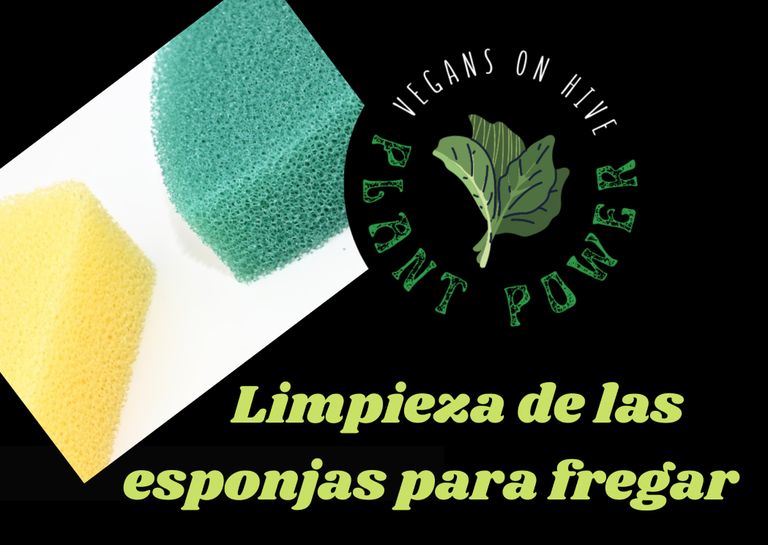
ENGLISH
Hello plant-based foodies, wherever you are in the world and/or galaxy!
Here @sirenahippie

There are many types of scrubbing sponges. According to the material with which they are made, there are metal ones, which are used to wash pots and kitchen counters, as well as to remove dirt that is very adhered to any utensil or surface. There are also plant-based ones, which have a softer texture. There are other silicone ones, which have a special treatment to prevent the proliferation of fungi, bacteria, etc. There are microfiber sponges that, due to their softness, are ideal for washing delicate dishes. There are more common ones, made of foam rubber, which generally come with a bumper or a rougher layer, making them more versatile.

Now, what are the microbes that the use of dirty or contaminated scrubbing sponges can transmit to us? Let's see what they are:
- Escherichia coli: Can cause hemorrhagic diarrhea, kidney failure and even death.
- Salmonella: Diarrhea, gastroenteritis and even typhoid fever.
- Staphylococcus aureus: Pneumonia, endocarditis (inflammation of the layer that forms the chambers and valves of the heart), osteomyelitis (bone infection), and skin infections.
As you can see, there is a risk of becoming infected with pathologies that can be fatal.

METHODS FOR CLEANING SCRUBBING SPONGES
- Boil the sponges: In a saucepan, boil the sponges for 10 minutes. Keep in mind that certain sponges can deform or deteriorate with heat. A little dishwashing detergent can be added to the water.
- Soak for 15 minutes in a solution of very hot water with white vinegar: Vinegar, due to its pH, has a bactericidal power, it can eliminate many bacteria, very hot water also helps in this process.
- Soak for 15 minutes in a solution of very hot water with baking soda: Like vinegar, baking soda has an important bactericidal power, which eliminates many microbes.

HOW TO KEEP SCRUBBING SPONGES CLEAN?
- Disinfect them frequently, either daily or every other day: Any of the previously described methods can be applied.
- Squeeze the sponges well: After using them, rinse them well and squeeze them as best as possible to remove as much moisture or water as possible.
- Dry them in the sun: Sunlight can eliminate some microbes, so it is recommended to place them in sunlight, so that they dry and are partially disinfected.
- Store them properly: After using them, rinsing them, squeezing them and, if possible, drying them in the sun, store them away from humidity and confinement.
- Avoid exposure to harmful insects: Flies and cockroaches can transmit many bacteria, viruses, fungi and parasites, so it is necessary that sponges are not in contact with these animals.
- Do not use sponges to scrub, to wash vegetables and fruits: To wash vegetables and fruits you should have another sponge or a brush, exclusively for this purpose.
- Do not use scouring sponges to clean surfaces where raw meats have been placed: Raw meats can transmit many harmful bacteria and microorganisms, which is why the surfaces where such items are placed should be cleaned with disposable paper, or washed with sponges other than those used to scrub dishes or other kitchen surfaces.
- Replace frequently: It is recommended to dispose of scouring sponges every two weeks or at least monthly. Sponges that are no longer used can be used to wash walls, tiles and other surfaces.

IMPORTANCE OF KEEPING SCRUBBING SPONGES CLEAN
- Cross contamination is avoided: This implies that any pathogen present on a surface or that is in the sponge itself, cannot contaminate the tableware, cutlery and plates that we use regularly, and thus we do not get sick.
- Unpleasant odors are not transmitted: Sometimes we can wash utensils that have the smell of some food, and if precautions are not taken, this smell can be transmitted to other surfaces or utensils, which is very unpleasant. By maintaining the cleanliness of the scouring sponges, these situations are avoided.
- The cleanliness of kitchen surfaces is maintained: By keeping scouring sponges clean, the possibility of microorganisms in this important area is reduced.

Disinfecting and keeping dish sponges clean are simple practices, but essential in any kitchen, because this prevents the presence and transmission of pathogens that can cause many diseases, some of them fatal to humans.


ESPAÑOL

¡Hola amantes de los alimentos basados en plantas, dondequiera que estén en el mundo y/o la galaxia!
Aquí @sirenahippie

Existen muchos tipos de esponjas para fregar. De acuerdo al material con el cual están hechas, están las metálicas, que se usan para lavar ollas y topes de cocina, así como para retirar sucio que esté muy adherido a cualquier utensilio o superficie. También las hay de origen vegetal, que son de una textura más suave. Existen otras de silicona, que tienen un tratamiento especial para evitar la proliferación de hongos, bacterias, etc. Hay esponjas de microfibra que por su suavidad son idóneas para lavar vajillas delicadas. Hay unas más communes, de goma espuma, que por lo general vienen con un tope o una capa más áspera, haciéndolas más versátiles.

Ahora bien, ¿cuáles son los microbios que pueden nos puede transmitir el uso de esponjas para fregar sucias o contaminadas? Veamos cuáles son:
- Escherichia coli: Puede causar diarrea hemorrágica, insuficiencia renal e incluso, la muerte.
- Salmonella: Diarrea, gastroenteritis e incluso, fiebre tifoidea.
- Staphylococcus aureus: Neumonía, endocarditis (inflamación de la capa que forma las cámaras y válvulas del corazón), osteomielitis (infección de los huesos), e infecciones de piel.
Como pueden ver, se corre el riesgo de contaminarse de patologías que pueden llegar a ser mortales.

MÉTODOS DE LIMPIEZA DE LAS ESPONJAS PARA FREGAR
- Hervir las esponjas: En una cacerola poner a hervir las esponjas por 10 minutos. Tener en cuenta que ciertas esponjas pueden deformarse o deteriorarse con el calor. Puede añadirse al agua un poco de detergente lavavajillas.
- Remojar por 15 minutos en una solución de agua muy caliente con vinagre blanco: El vinagre, debido a su pH, tiene un poder bactericida, puede eliminar muchas bacterias, el agua muy caliente también ayuda en este proceso.
- Remojar por 15 minutos en una solución de agua muy caliente con bicarbonato de sodio: Al igual que el vinagre, el bicarbonato de sodio tiene un importante poder bactericida, que elimina muchos microbios.

¿CÓMO MANTENER LIMPIAS LAS ESPONJAS PARA FREGAR?
- Desinfectarlas con frecuencia, ya sea diario o interdiario: Puede aplicarse cualquiera de los métodos previamente descritos.
- Exprimir bien las esponjas: Luego de usarlas es preciso enjuagarlas bien, y exprimirlas lo mejor posible, para retirar la mayor cantidad de humedad o agua.
- Secarlas al sol: La luz solar puede eliminar algunos microbios, por lo que se recomienda colocarlas a la luz solar, para que se sequen y se desinfecten en parte.
- Almacenarlas adecuadamente: Luego de hacer uso de ellas, de enjuagarlas, exprimirlas y de ser posible secarlas al sol, guardarlas fuera de la humedad y el encierro.
- Evitar la exposición a insectos nocivos: Las moscas y cucarachas pueden trasmitir muchas bacterias, virus, hongos y parásitos, así que es necesario que las esponjas no estén en contacto con esos animales.
- No usar las esponjas para fregar, para lavar verduras y frutas: Para lavar verduras y frutas se debe tener otra esponja o un cepillo, exclusivamente para ello.
- No usar las esponjas para fregar para limpiar superficies en donde se hayan colocado carnes crudas: Las carnes crudas pueden transmitir muchas bacterias y microorganismos nocivos, razón por la cual las superficies en donde se coloquen tales elementos, deben ser limpiadas con papel desechable, o lavarlas con otras esponjas diferentes a las que se usan para fregar la vajilla u otras superficies de la cocina.
- Sustituirlas con frecuencia: Se recomienda desechar las esponjas para fregar cada dos semanas o al menos, mensualmente. Las esponjas que ya no se usan, pueden emplearse para lavar paredes, azulejos y otras superficies.

IMPORTANCIA DE MANTENER LIMPIAS LAS ESPONJAS PARA FREGAR
- Se evita la contaminación cruzada: Esto implica que algún patógeno presente en alguna superficie o que esté en la misma esponja, no pueda contaminar las vajillas, cubiertos y platos que usamos regularmente, y así no nos enfermamos.
- No se transmiten olores desagradables: En ocasiones podemos lavar algún utensilio que tenga el olor de alguna comida, y si no se toman las precauciones, este olor puede trasmitirse a otras superficies o utensilios, lo cual es muy desagradable. Manteniendo la limpieza de las esponjas para fregar, se evitan estas situaciones.
- Se mantiene el aseo de las superficies de la cocina: Al mantener limpias las esponjas para fregar, se disminuye la posibilidad de que hayan microorganismos en esta área tan importante.

Desinfectar y mantener limpias las esponjas de fregar, son prácticas simples, pero indispensables en cualquier cocina, porque así se evita la presencia y transmisión de patógenos que pueden ocasionar muchas enfermedades, algunas de ellas mortales para el ser humano.

BIBLIOGRAPHY / BIBLIOGRAFÍA

RELATED POSTS / POSTS RELACIONADOS


Delegations welcome!
Esta información es muy importante, las esponjas tienen contacto permanente con los utensilios que usamos para comer y todas esas bacterias pueden ingresar a nuestro organismo. Lo bueno es que podemos desinfectarlas con ingredientes que siempre tenemos en casa. Saludos.